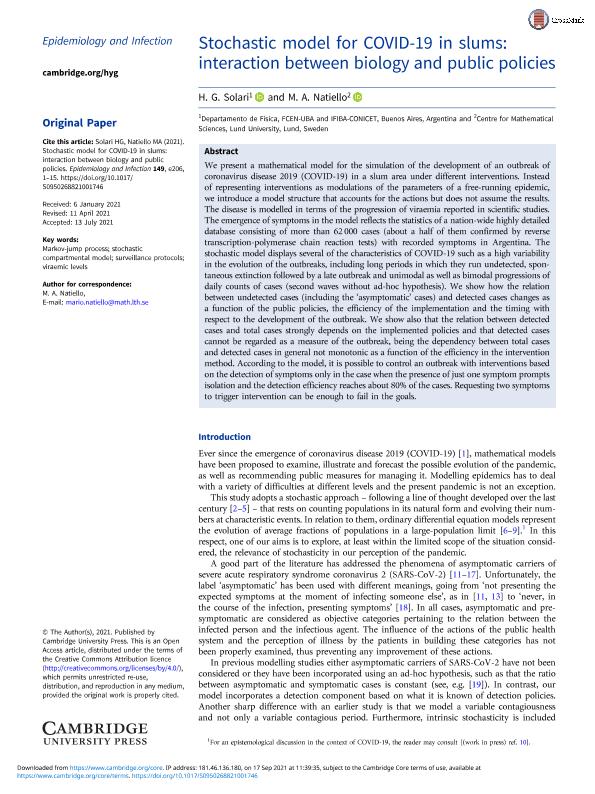Mostrar el registro sencillo del ítem
dc.contributor.author
Solari, Hernan Gustavo

dc.contributor.author
Natiello, Mario Alberto

dc.date.available
2023-08-30T14:33:36Z
dc.date.issued
2021-07
dc.identifier.citation
Solari, Hernan Gustavo; Natiello, Mario Alberto; Stochastic model for COVID-19 in slums: Interaction between biology and public policies; Cambridge University Press; Epidemiology and Infection; 149; 7-2021; 1-15
dc.identifier.issn
0950-2688
dc.identifier.uri
http://hdl.handle.net/11336/209885
dc.description.abstract
We present a mathematical model for the simulation of the development of an outbreak of coronavirus disease 2019 (COVID-19) in a slum area under different interventions. Instead of representing interventions as modulations of the parameters of a free-running epidemic, we introduce a model structure that accounts for the actions but does not assume the results. The disease is modelled in terms of the progression of viraemia reported in scientific studies. The emergence of symptoms in the model reflects the statistics of a nation-wide highly detailed database consisting of more than 62 000 cases (about a half of them confirmed by reverse transcription-polymerase chain reaction tests) with recorded symptoms in Argentina. The stochastic model displays several of the characteristics of COVID-19 such as a high variability in the evolution of the outbreaks, including long periods in which they run undetected, spontaneous extinction followed by a late outbreak and unimodal as well as bimodal progressions of daily counts of cases (second waves without ad-hoc hypothesis). We show how the relation between undetected cases (including the 'asymptomatic' cases) and detected cases changes as a function of the public policies, the efficiency of the implementation and the timing with respect to the development of the outbreak. We show also that the relation between detected cases and total cases strongly depends on the implemented policies and that detected cases cannot be regarded as a measure of the outbreak, being the dependency between total cases and detected cases in general not monotonic as a function of the efficiency in the intervention method. According to the model, it is possible to control an outbreak with interventions based on the detection of symptoms only in the case when the presence of just one symptom prompts isolation and the detection efficiency reaches about 80% of the cases. Requesting two symptoms to trigger intervention can be enough to fail in the goals.
dc.format
application/pdf
dc.language.iso
eng
dc.publisher
Cambridge University Press

dc.rights
info:eu-repo/semantics/openAccess
dc.rights.uri
https://creativecommons.org/licenses/by/2.5/ar/
dc.subject
MARKOV-JUMP PROCESS
dc.subject
STOCHASTIC COMPARTMENTAL MODEL
dc.subject
SURVEILLANCE PROTOCOLS
dc.subject
VIRAEMIC LEVELS
dc.subject.classification
Matemática Aplicada

dc.subject.classification
Matemáticas

dc.subject.classification
CIENCIAS NATURALES Y EXACTAS

dc.title
Stochastic model for COVID-19 in slums: Interaction between biology and public policies
dc.type
info:eu-repo/semantics/article
dc.type
info:ar-repo/semantics/artículo
dc.type
info:eu-repo/semantics/publishedVersion
dc.date.updated
2023-08-30T10:43:30Z
dc.journal.volume
149
dc.journal.pagination
1-15
dc.journal.pais
Reino Unido

dc.journal.ciudad
Cambridge
dc.description.fil
Fil: Solari, Hernan Gustavo. Consejo Nacional de Investigaciones Científicas y Técnicas. Oficina de Coordinación Administrativa Ciudad Universitaria. Instituto de Física de Buenos Aires. Universidad de Buenos Aires. Facultad de Ciencias Exactas y Naturales. Instituto de Física de Buenos Aires; Argentina
dc.description.fil
Fil: Natiello, Mario Alberto. Lund University; Suecia
dc.journal.title
Epidemiology and Infection

dc.relation.alternativeid
info:eu-repo/semantics/altIdentifier/doi/http://dx.doi.org/10.1017/S0950268821001746
dc.relation.alternativeid
info:eu-repo/semantics/altIdentifier/url/https://www.cambridge.org/core/journals/epidemiology-and-infection/article/stochastic-model-for-covid19-in-slums-interaction-between-biology-and-public-policies/49BE1C19F8297A9BDC5BCC52391B93A1
Archivos asociados
